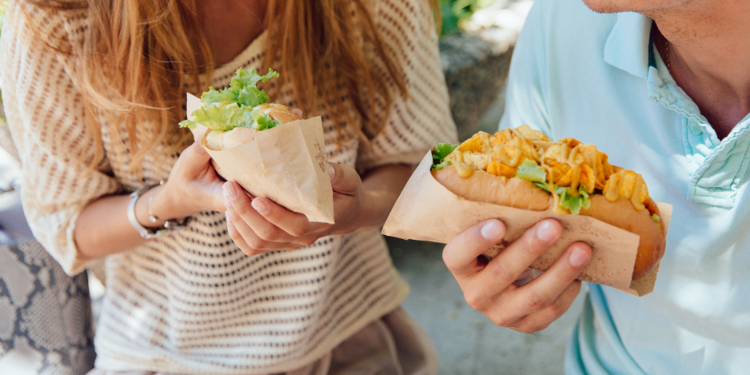
Street food isn’t only cheap, tasty, and easy to find around the country, but it’s also an authentic way to explore the local traditions and culture. Tackling the street food queue and interacting with the cooks puts you in the heart of the local society. You may find yourself practising your language skills when trying to order or find out more about the recipe, or you may start wandering in a neighbourhood that you had never visited before in search of the best food stall in your city. Also, choosing street food for your lunch, dinner, or snack is a flavoursome way to support the local economy. Expat.com has chosen the tastiest street foods from the most attractive expat destinations and warns you that by the end of this article you will be hungry.
Belgium: Waffles

You may have never been to Belgium, but most likely you have eaten waffles elsewhere, with ice-cream or melted chocolate and strawberries toppings. However, waffles date back to the Middle Ages and were sold outside churches in Belgium. This crispy and rich snack was made of barley and oats, and was as popular then as it is today, in spite of its variations. Officially, there are two types of Belgium waffles: the fluffy Brussels waffles, which should be eaten with the hands, and the Liege waffles, which are thick and sticky. Which one is your favourite?
Morocco: Tajine

Tajine is named after the clay pot, which has a flat circular base and a cone-shaped lead, in which it is slow-cooked. The original stew is made of lamb or chicken with additional ingredients such as dry fruits, olives, honey, lemons, and spices such as cinnamon, saffron, paprika, turmeric, and cumin. If you wish to impress the vendors in Morocco with your knowledge, you can ask for a kefta tajine (meatballs in tomato sauce) or mrouzia tajine (lamb with raisins and almonds). Don't expect cutleries for this shared dish; use the flatbread to scoop your bites.
South Korea: Kimbap

Kimbap or gimbap is the closest alternative you will get to the Japanese sushi rolls. The South Korean kimbap is made with steamed white rice wrapped in dried seaweed, and comes in all kind of styles (e.g. beef, cheese, veggies, kimchi, tuna, pork, crab sticks). You can season your kimbap with sesame oil. Kimbap isn't only sold at stalls, but in the fridges of convenience shops too.
South Africa: Bunny Chow

Bunny chow is a dark curry of lamb, mutton, chicken, or vegetables and beans in a hollowed out white bread. Bunny chow originated in Durban, as a result of the culinary traditions that the Indian servants brought with them to the sugarcane plantations. However, this filling street food first appeared in Durban in the 1940s, and became extremely popular during apartheid for the people of colour who were not allowed in restaurants. The name bunny chow comes from the Sanskrit word bania, which means merchant.
Portugal: Pastel de Nata

Three-hundred years ago the monks of the Jerónimos Monastery in the parish of Belém used the leftover egg yolks to make desserts — one of them being the pastéis de nata, which they were selling to support the monastery financially. In spite of their efforts, the monastery closed in 1834, and they sold the recipe to what it is today the Fábrica de Pastéis de Belém — the best place to try the original creamy hybrid of tart and cake. However, pastel de nata are widely found in Portugal, making for an excellent street dessert at any time of the day.
Mexico: Tostadas

Even if your Spanish is zero, you can probably guess what does the word tostadas mean (indeed; it means toasted). Tostadas are corn or flour tortillas, which are either baked or fried — cooking processes that give shelf life for weeks or make stale and soft tortillas edible again. Mexican tostadas are crispy, and their shape is either flat or rounded as a bowl to put the toppings (seafood, beans, or meat along with guacamole, salsa, and cheese) inside.
France: Crêpe

Sweet or savoury, crêpes can be eaten at any time of the day. This traditional French street food is made with buckwheat flour, and is filled with whatever you desire — from ham, cheese, and mushrooms to fresh fruits, chocolate spread, and even alcohol. Buckwheat arrived in Brittany in the 12th century, and soon after, the Bretons started making these delicious folded pancakes. The bonus of France's street food is that it's easy to eat on the go without putting your white shirt at risk, as all the ingredients are held tight together inside the crêpe. Crêpes are so honoured in France that they have their celebration on the 2nd of February, known as “the day of crepes.”
Japan: Takoyaki

We are not sure whether the real pleasure of takoyaki comes from watching the chefs skillfully turning the octopus balls with their long toothpicks to help them cook evenly, or from the texture and taste of the warm fluffy dough. But you don't have to answer this question, as you can have the full experience of watching and eating. Each takoyaki is cooked in an individual iron griddle, similar to what is used for cupcakes, and is served hot; garnished with takoyaki sauce and powdered seaweed. Takoyaki was invented in the early 1930s by a street vendor in Osaka, and quickly gained popularity throughout Japan. No wonder.
Mauritius: Dhal Puri

Daily life in the tropical island of the Indian Ocean is filled with fresh ingredients and colours, both of which are evident in the local cuisine. With influences from France and India among other cultures, Mauritius has its version of pancake made from ground yellow split peas. Dhal Puri or Dholl Puri is a flatbread seasoned with cumin and turmeric, and filled with butter bean curry, Creole tomato sauce (spicy alert), pickled vegetables, chutney, and more chilli for the brave ones. Dholl puri originated from Indian parathas about a century ago, and was introduced by the Bihar labourers. However, nowadays, thanks to the local ingredients and expertise it is recognised merely as a Mauritian speciality.



















